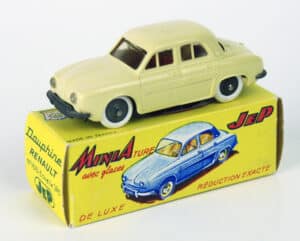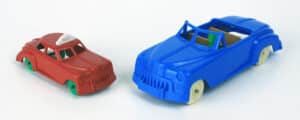by Douglas R. Kelly

Ironing vintage toy boxes and writing about the process in the February issue of the Journal got me thinking about some of the other boxes on my shelves. The yellow box shown here came to me in a roundabout way. I bought the cream-colored Renault Dauphine from my friend Jeff Bray more than 20 years ago, and I wasn’t bothered by the lack of a box due to the model’s rarity. French manufacturer JEP (Jouets de Paris) produced a series of five 1:43 scale plastic model cars in 1958, each of them having a cast metal baseplate/chassis, which gave them a weight that you usually don’t find in a plastic toy car.
I’ve always loved the shape of the Dauphine, and JEP did a great job on this miniature version (same with the other models in the series). After it had graced my cabinet for a couple of years, I visited Jeff at his warehouse in Connecticut. I was sitting on a stool among rows of steel shelving, digging through filing boxes of miscellaneous items, mostly newer toys and toy catalogs, when I uncovered the yellow JEP box. At first, I wondered if it was a reproduction box, given that the things rarely turn up, but it was all original. I realized that it likely had become separated from the Dauphine a few years earlier, and I shouted to Jeff (who was in another room), “Hey, you should come see this.” I held the box up as he walked through the door, and once his eyes focused on it, he said, “No way.” I said oh, yes, way, and I asked if he remembered my haranguing him about the lack of a box a couple of years earlier, and he said, “How could I forget? I must have misplaced the box somehow when I sorted through the JEP models that came in.”
The box was complete and in great shape, and it has specs and performance numbers for the full-size Dauphine on the back (in French, of course). I said that I’d add the box to the pile of toy cars that I intended to buy from him that day, but Jeff said, “No, that one’s on the house. I’m just glad that toy and box will be reunited.” An officer and a gentleman, my friend Jeff.


If you’re a regular reader of this “Toys from the Attic” section of the Journal, you’ll recognize the Robby the Robot figure, which I waxed eloquently (or at least obsessively) about in the August 2024 issue. Masudaya produced this plastic four-inch tall wind-up in 1984, and I bought a couple of them as soon as I heard about them. The box is one of my all-time favorites because—along with the wonderful planetary artwork and the lift-off lid/sleeve—it came with a textured gold-colored foam insert that looks like some kind of transporter chamber. It’s a cool touch that adds to the fun of owning Robby.
When an empty box for a desirable and/or rare toy comes along (in these cases, a toy that I don’t have), I try to buy it in hopes of eventually matching it to a nice example of the toy. That’s worked out in several cases, but like most collectors, I have many more toys without boxes than the other way ‘round. The small plastic cars and trucks made by Allied in the U.S. and by Cheerio in Canada in the 1950s fall into that boxless category for me … I’ve assembled a nice collection of the three-inch cars and trucks over the years, but I’ve yet to see a box for any of them. They’re simple one-piece castings, but they were beautifully made and are incredibly evocative of that era in automotive style. And as scarce as the three-inch cars and trucks are, I’ve seen just one example of the five-inch cars that one of the two companies produced, and I bought it the moment I laid eyes on it.

While the five-inch car might have come in an individual box, it’s more likely that it and the three-inch models came in “trade” boxes. That is, counter display boxes containing 12 or 24 or 36 examples for kids to choose from and get Mom or Dad to buy for them.
Now THAT would make for a beautiful display piece with the cars and delivery trucks and ambulances. Who says baseball cards are the only cardboard dreams?
Douglas R. Kelly is the editor of Marine Technology magazine. His byline has appeared in Antiques Roadshow Insider; Back Issue; Diecast Collector; RetroFan; and Buildings magazines.






Related posts: